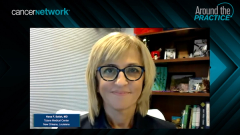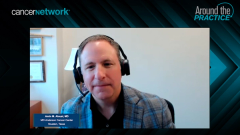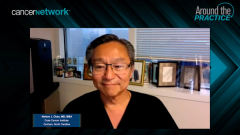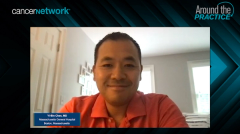
Scenario 2: A 59-Year-Old Woman With Chronic GVHD
After reviewing a clinical scenario of chronic graft vs host disease, panelists consider the importance of different allogeneic transplant types.
Episodes in this series

Transcript:
Yi-Bin Chen, MD: We’re going to move on to case 2, which will focus on advancement in chronic graft-vs-host disease [GVHD]. Let me go through the case. This is a 59-year-old woman. She underwent a matched-unrelated donor transplant using peripheral blood stem cells for an underlying diagnosis of AML [acute myeloid leukemia]. Her conditioning was myeloablative, and she also received tacrolimus [Prograf] and methotrexate [Rheumatrex] for GVHD prevention. Her initial post-transplant course was fairly uncomplicated. She went through the first year well and with minimal complications. Immunosuppression was tapered as scheduled because she didn’t have acute or chronic GVHD during that first year.
But at her 13-month visit, she presented with the sensation of a foreign body in her eyes. She felt as if there was always sand in there and complained that her eyes were very dry. She was prescribed steroid eye drops as a first-line treatment. We might do some Restasis or cyclosporine eye drops as needed. Her symptoms did not worsen, but they persisted. At 16 months, about 3 months after that, she presented with diffuse muscle and joint pain that was limiting her daily exercise routine. She was still fairly active and participating in life but started to have some difficulty due to her symptoms. Systemic prednisone was added. At 20 months, 4 months after prednisone was added, it was noted on physical exam that she had started to develop sclerodermatous changes and had decreased range of motion in a few joints. The pulmonary function test showed a decreased FEV1 [forced expiratory volume in 1 second] and DLCO [diffuse capacity of lung for carbon monoxide].
That’s the case. We can paint some more details, but in terms of initial impressions, Nelson, can you talk about the significance of her having received peripheral blood stem cells? Why does that matter when thinking about chronic graft-vs-host disease?
Nelson J. Chao, MD, MBA: There’s a nice study done by the BMT CTN [Blood and Marrow Transplant Clinical Trials Network] in which they randomized patients to bone marrow vs peripheral blood. That study showed no difference in the overall outcome, but clearly chronic GVHD is the highest in those who got peripheral blood. The incidence was significantly higher in those patients with peripheral blood. When we use peripheral blood, we know that the chance of getting chronic GVHD is going to be greater.
Yi-Bin Chen, MD: That study was published about 10 years ago. The data haven’t changed practice that much in terms of increasing the use of bone marrow. The population of that study was myeloablative-unrelated donor transplants. Any idea why that didn’t change practice before? Can you touch on how recent world events have influenced how we get stem cells sourced from donors?
Amin M. Alousi, MD: It’s a difficult question to get at. We don’t know why it hasn’t changed practice. There are higher rates of chronic GVHD, and long-term follow-up results from that trial looked at much poorer long-term quality of life in those who received peripheral blood vs bone marrow. The likelihood of return to employment was much lower in the group that received peripheral blood vs bone marrow. If patients knew the results of that follow-up trial, they’d voice their opinion and practice may change, but that information isn’t widely disseminated in patient portals and discussion groups. That hasn’t changed practice. Once a practice is established, it’s hard to change people’s and clinicians’ behavior.
Early on, there was a belief that peripheral blood may lower the risk of relapse. When you look at the results of that study in the CTN [Clinical Trials Network] trial, relapse rates were identical between those 2 arms. But there’s still a widely disseminated belief that blood stem cells lower the risk of recurrence. You’ll hear clinicians say, “I was so worried about my high-risk population.”
COVID-19 may have changed the practice, so you can get quicker engraftment. Blood stem cells can graft quicker than bone marrow. Having the cells cryopreserved, being able to give it and getting quick recovery is something that clinicians thought were important in the middle of a pandemic. There can be some concerns with cryopreserving bone marrow, although it can certainly be done. Those are some of the reasons why practice hasn’t changed as much as it should have, based on what we know about the risk of graft-vs-host disease in those who get blood stem cells.
Yi-Bin Chen, MD: Do you have any thoughts to add to that, Hana?
Hana F. Safah, MD: We change some practices. With aplastic anemia, for instance, we just do bone marrow. With a mismatch, we ask for bone marrow. I don’t know about the advantage to collect bone marrow if we ask for bone marrow more. It’s easier to send a donor for peripheral blood collection compared with getting a donor to have a bone marrow harvest. Who’s going to do the bone marrow harvest, because transplant physicians are the ones usually in the collection center. They’re the ones responsible for harvesting with midlevel. If we increase the number, who’s going to be able to do that and have it done in a timely fashion? I deal with it all the time. OR [operation room] time is limited to surgeons, and we have limited resources with COVID-19—nurses, availability. You’re right: that trial should be an eye-opener. It opened our eyes to this. When we’re asked for the most likely patient for GVHD, we ask for bone marrow stem cells, but can it be done on widely basis? I’m not sure. There are a lot of challenges that have to be overcome.
Yi-Bin Chen, MD: The increased resource utilization of a bone marrow harvest is an issue. There are some sites, and we talk about it at our site, where the harvest itself is very subjective to the operator. Sometimes we receive harvests of questionable yield. You wonder what the technique is that’s being used. Studies have shown that training on bone marrow harvests has decreased significantly over the last couple of decades, but that’s a cycle that if you don’t do them, you won’t get trained. It’s an interesting dynamic. It’s a very interesting dynamic. Add all the travel difficulties and the need to cryopreserve around COVID-19, and it certainly hasn’t made it easier to obtain fresh, unrelated donor bone marrow.
Transcript edited for clarity.
Newsletter
Stay up to date on recent advances in the multidisciplinary approach to cancer.




































































































